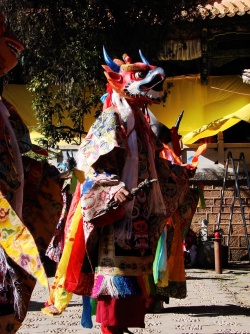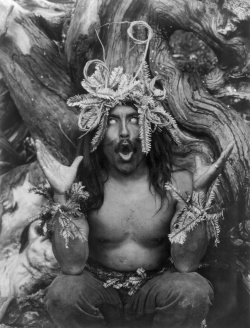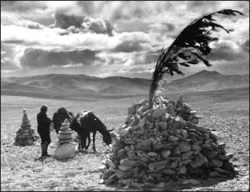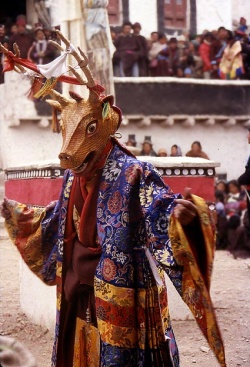A Critical Genealogy of Shamanism in Tibetan Religions PART I: Introduction
PART I: Introduction
In descriptions of the Bon religion in Tibet by western missionaries, travelers, and scholars over the last century, the term that has become most associated with Bon is "Shamanism." Shamanism has been used to re-name what is widely regarded as Tibet's primordial native religion; its endurance as a category demonstrates a need to designate the indigenous religion
in familiar western terms. There is a deep longing felt by many scholars, both past and present, to recover Tibet's silent origins, to identify the tracks of Tibet's prehistoric religious development, and then to discover whatever modern manifestations might exist on the margins of Tibet. This longing exerts a powerful pull on the imaginations of Tibetans
and Tibetologists alike. In introducing his study of the myths and legends of ancient Tibet, Erik Haarh expresses his own fascination with exploring Tibet's uncharted territory: Studying the ancient Tibetan concept of life and death means intruding upon virgin soil. This feature of old Tibetan culture is, indeed, so utterly unknown and unexplored, that the ideas which have been advanced above, in the first instant may even appear with the cast of chimera.... Very few Tibetologists have ventured
forth to explore, even superficially, this blank spot on the map of ancient Tibetan culture and history.[1] Haarh's description of the pre-Buddhist period as a "blank spot" on the Tibetan map might seem apt when one considers the paucity of archeological and
textual evidence available today about pre-Buddhist Tibet. Yet there seems to be a magnetic quality to this lacuna. The "blank spot" has been filled in by the imaginative projections of pioneering Tibetologists, with Shamanism as the label of choice for mapping this territory. We will see that Shamanism itself has "the cast of chimera," for it is an elusive term that tells us more
about the history and needs of the western researcher than of ancient Tibet. Like its conceptual kin "Tantrism" or "Lamaism,"[2] "Shamanism" proves to be a remarkably complex, multivalent term that has informed our interpretation and evaluation of Tibetan religion, and especially the relationship of Bon to Buddhism. In the late nineteenth and early twentieth century, many western writers used Shamanism as a monolithic category to subsume a great variety of religious phenomena. Most often it was assigned to the "native" tradition of Bon, with its dark
occult practices. Black magic, fetishism, sorcery, divination, demonolatry, necromancy, exorcism, ecstatic trance, spirit possession, and various other supernatural powers were all thought to lie at the heart of Bon Shamanism.
Though this noun was used loosely and indiscriminately, its function as an emblem of Tibet's ancient religious substrata becomes most evident when it is working behind the scenes in the drama of Tibetan history, a drama in which scholars cast Buddhism in the spotlight. For many of the early Tibetologists, aboriginal Bon was regarded as "given" or "uninterpreted," which gave them license to impose their own categories to label its strange features. Like so many other categories used in the study of "native" religions,
shamanism begs to be analyzed as an exotic essence that is used for identifying the religion of the other, marking a "primitive" stage of religious and social evolution. This article will trace how the pejorative evaluation of Bon shamanism comes to be challenged in the mid-twentieth century with the development of phenomenological studies of Tibetan
religion. These "scientific" studies of Tibetan shamanism systematically catalogue its typical features, and the investigators often eschew the barbaric rhetoric that had been used to dismiss Bon as "primitive." Once the features of shamanism are identified, and the shaman's social function is described, the phenomenologist devotes considerable
attention to describing the shaman's experience and to interpreting the shaman's symbolism. There is no hiding the fascination that these scholars feel for the Bon shaman as the exotic explorer of the netherworlds, with his wild theatrical appearance. Some scholars seem under a nostalgic spell when they idealize shamanism as Tibet's genuine archaic spirituality.
Among recent anthropologists, shamans in Nepal and Tibet have come to be understood in relation to Buddhist lamas, with their social and religious roles interpreted dialectically. In pitting shamans in duel and dialogue with Buddhist lamas, the shamans are often celebrated as spirit mediums whose "deconstructive voices" subvert
Buddhist textual authority and the hegemony of clerical values. Here shamans have been salvaged by anthropologists as authentic healers, whose ecstatic experiences place them in a privileged position to criticize and resist the official orthodoxy of Buddhist lamas. For some anthropologists the shaman, whose roots go back to ancient Bon, is a trickster who undermines the elitism
of their Buddhist opponents, subverting their moral seriousness and their dependence on textual knowledge. Some Tibetologists remain skeptical of the value of "shamanism" in plotting the religious features of Bon, for they recognize that the term itself has the "cast of chimera." Numerous European scholars who study Bon literature have pointed out that the abstract noun "shamanism" has no equivalent in the Tibetan language, and thus it is not a "native" category. They deny that the Bon
tradition has any precise analogue to the Tungus⁄aman of Siberia. "Shamanism" in their estimation, is simply inappropriate for describing Bon, or indeed for describing any aspect of Tibetan religion. These textual scholars have sought to banish the ghost of "shamanism" from the study of Bon entirely. Their wish to deflate the term's value in academic
discourse about Bon and Tibetan religion has not proved successful, however. Shamanism has earned a widespread currency in academic exchange, a much-inflated value in popular western spiritual circles, and even acceptance among Tibetans
practicing in the west today. Current anthropologists, not to mention western enthusiasts of Buddhism and Tibetan Bonpos themselves, continue to find new manifestations of shamanism in Tibetan religion.
Despite the protests of some of the leading western Tibetologists then, shamanism continues to resurface in the literature available on Bon and Buddhism, proving its resilience as a critical term.[3] From a vantagepoint located at some distance from the field of
Tibetan Studies, it will become clear that shamanism is not a single natural object that has been progressively disclosed by the objective scrutiny of western scholars. Rather, shamanism is a term that has been employed for a variety of ideological purposes. What makes the Bon shaman such an interesting image to track, from the benighted primitive to the post-modern
visionary, from the diabolical priest to the New Age spiritual healer, is that it serves as a mirror that reveals much about those who have sought (and found) the shaman. The Bon shaman has been variously identified and represented according to the changing imaginative and social needs of the investigators. Wherever it has been identified-whether in texts, or in
a lived social environment, or in symbol systems-its location has influenced the form of reasoning used to render it intelligible. As Jean-Pierre Vernant stated succinctly, the subject of a scholar's study is constrained by the reasoning and the disciplinary methods available: Reason does not exist until human beings attempt to understand some aspect of reality and to apply what they learn. Scientific rationality defines itself as it constructs the subject matter and methodology of
each new discipline. In the human sciences, moreover, there is no virgin territory to explore; the fields of investigation are continents mapped by tradition and explored by religious thought. Trails have been blazed, itineraries set out. The problems that arise in any new field of study are always in some sense echoes of current social concerns, questions of identity:
society seeks to know its roots in the past, its responsibilities in the present, and its fate in the future.[4] Far from being "neutral" or "
objective," the methods used by historians, philologists, and anthropologists are inevitably socially conditioned and informed by religious tradition. Vernant's comment that there is "no virgin territory to explore" in the human sciences applies to both ancient Tibet and modern Tibetology too, and it raises questions about Haarh's earlier assertion. When scholars like
Haarh have set out to map the territory of prehistoric Tibetan religion, their representations have followed the paths already blazed by Tibetan Buddhists, who developed their own images, categories, and classificatory schemas to describe Bon as "other." What went unrecognized by many Tibetologists is how much their imaginative construction of ancient Tibetan history and Bon Shamanism was indebted to Buddhist apologetics and polemics.
It is therefore a mistake to dismiss Bon shamanism as merely the product of the scholars' own disciplinary methods, religious biases, and intellectual fads, for their evaluation of Bon and their fixation on its strange "shamanic" features were informed by Buddhist polemical images too. The purpose of this article is to explore some of
these complex interconnections, the interplay between certain Tibetan and western categories in the evaluation of Bon as an object of study. In addition to presenting a rough chronological survey of the western study of Bon, and examining the varying features regarded as its shamanic characteristics, I will consider why the category shamanism is used and
what discursive purposes it has served. Although a number of well-known Tibetologists have dismissed the word as inappropriate for describing Bon, I will not simply rehearse their objections but offer a critical genealogy of the term, which continues to be used in representations of Bon. My task is to historicize a category that has too often been treated as "natural" in discourse on
Tibetan religions. In order to understand the fluctuating evaluations of Bon in terms of Tibet's religious development, I will also tease out their implicit historical models, noting at times their indebtedness to Tibetan histories and Buddhist-Bon polemics. At the heart of this project lies a problem that has been identified as the "age-old distinction between
the Same and the Other."[5] Seen in the Tibetan context, this is the problem of how to represent the Other (Bon) without collapsing it into the categories and definitions of the Same (the west, or Buddhism), and without making the Other so different
and unique that interpretation becomes impossible. I do not pretend to offer a solution to this age-old problem here, but rather to show how this tension has been played out in a specific field of discourse, with a reflexive awareness of the inherent tensions in representing the other. Some degree of freedom may be possible once one recognizes the constraints of one's field.
Continue Reading
- A Critical Genealogy of Shamanism in Tibetan Religions PART I: Introduction
- A Critical Genealogy of Shamanism in Tibetan Religions - PART II
- A Critical Genealogy of Shamanism in Tibetan Religions - PART III
- A Critical Genealogy of Shamanism in Tibetan Religions - PART IV
- A Critical Genealogy of Shamanism in Tibetan Religions - PART V
- A Critical Genealogy of Shamanism in Tibetan Religions - PART VI
Footnotes
- ↑ Erik Haarh, The Yarlung Dynasty: a study with particular regard to the contribution of myths and legends to the history of ancient Tibet and the origin and nature of its kings (Copenhagen: G.E.C. Gad's Forlag, 1969), p. 327.
- ↑ Both of these terms have served as emblems of Tibetan Buddhism in popular and academic discourse, and their usage has been investigated in a number of recent studies. The category of "Tantrism" has been scrutinized and its discursive purposes reviewed. See Christian K. Wedemeyer, "Tropes, Typologies, and Turnarounds: A Brief Genealogy of the Historiography of Tantric Buddhism" in History of Religions 40.3 (2002), 223-259. For an examination of the term Tantra in the Indo-Tibetan Buddhist context, see Donald S. Lopez, "The Heart Sutra as Tantra" in Elaborations on Emptiness (Princeton University Press, 1996), pp. 78- 104. For a genealogy of Tantrism within the British colonial imagination, see Hugh B. Urban, "The Extreme Orient: The Construction of ‘Tantrism' as a Category in the Orientalist Imagination," in Religion 29 (1999), pp. 123-146. Urban has examined the role of the category of Tantrism in New Age religious discourse in "The Cult of Ecstasy: Tantrism, the New Age, and the Spiritual Logic of Late Capitalism" History of Religions 39.2 (February 2000), pp. 268-302. For a critical genealogy of the term "Lamaism," see Donald S. Lopez, "‘Lamaism' and the Disappearance of Tibet" in Comparative Studies in Society and History, 38.1 (1996), pp. 3-25.
- ↑ For a study of "critical terms" in the discipline of religious studies, see Critical Terms for Religious Studies ed. by Mark C. Taylor (Chicago: University of Chicago Press, 1998), especially pp. 16-18. Also see Critical Terms for Literary Study, ed. By Frank Lentricchia and Thomas McLaughlin (Chicago: University of Chicago Press, 1995). In the Introduction to this latter volume, the editors offer the following etymology: "A ‘term' is a boundary line, a line of demarcation. It defines a field in which work can be done, within the limits of the term. But like all boundaries, even those meticulously surveyed, terms are social and arbitrary, not natural and inevitable. What divides my property from my neighbor's is not a natural boundary but a social system within which certain definitions or property prevail. It is important to remember that terms function in the same way. They limit and regulate our reading practices. But they do not do so by divine fiat.... It is not the job of this text to regulate those boundaries more carefully. Rather, these essays attempt to de-naturalize the limits that our critical system imposes." In this article I argue that "Shamanism" qualifies as such a "critical term" in the discourse on Bon.
- ↑ Jean-Pierre Vernant in his Forward to Maurice Olender's The Languages of Paradise: Race, Religion and Philology in the Nineteenth Century, trans. by Arthur Goldhammer (Cambridge: Harvard University Press, 1992), pp. viii-ix.
- ↑ Michel Foucault, The Order of Things: An Archaeology of the Human Science (London: Tavistock Publications, 1970), p. xv.
Source



